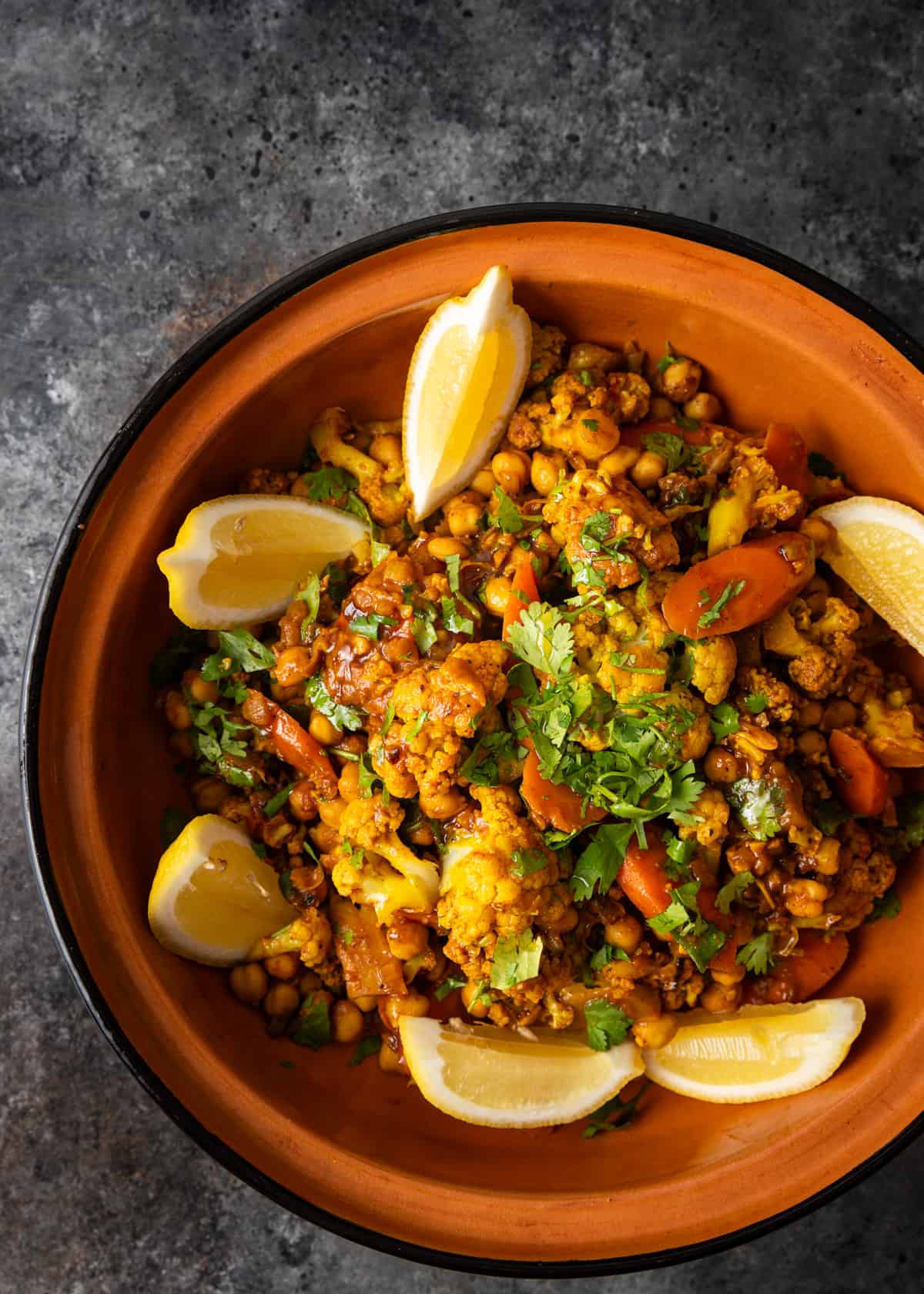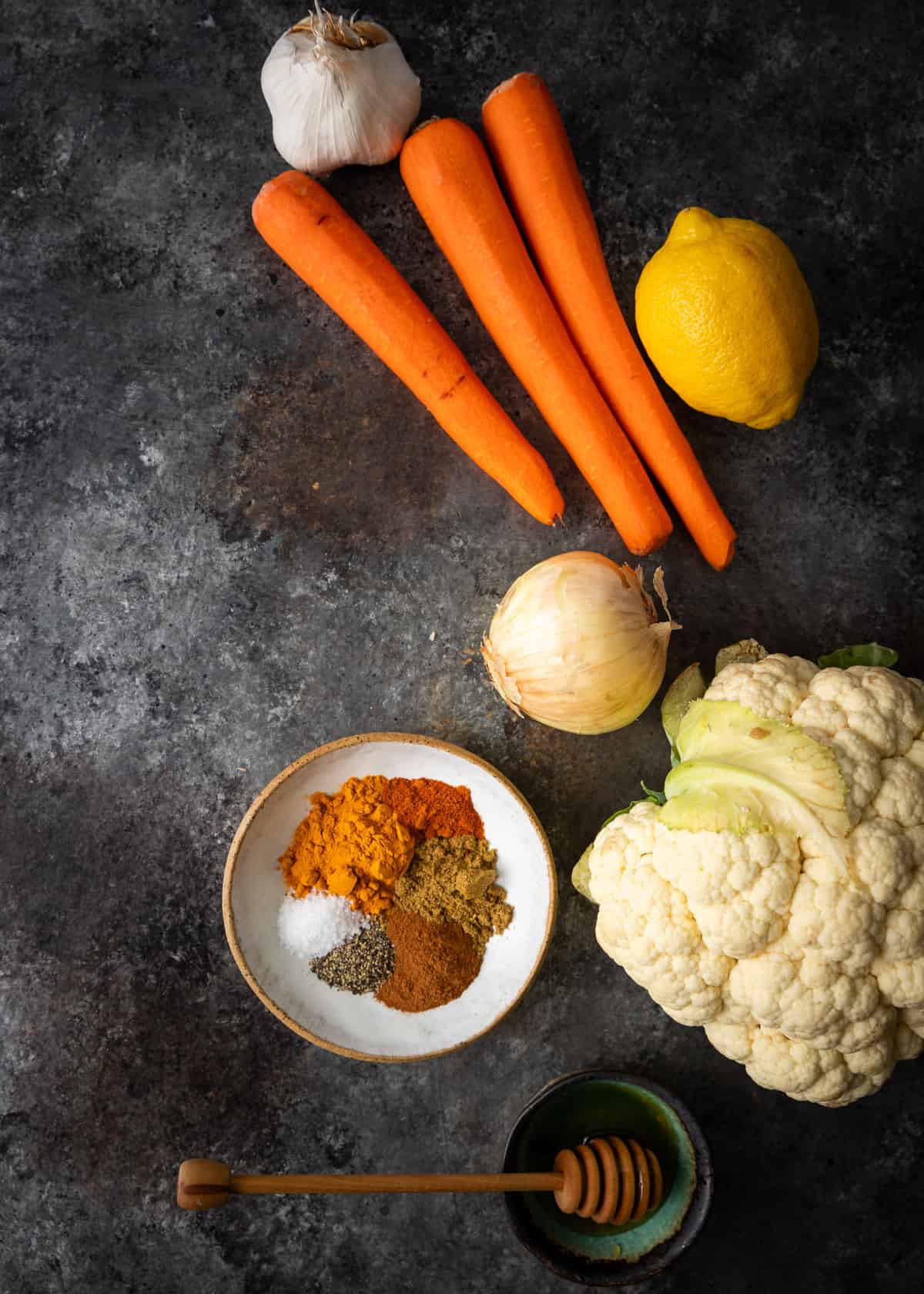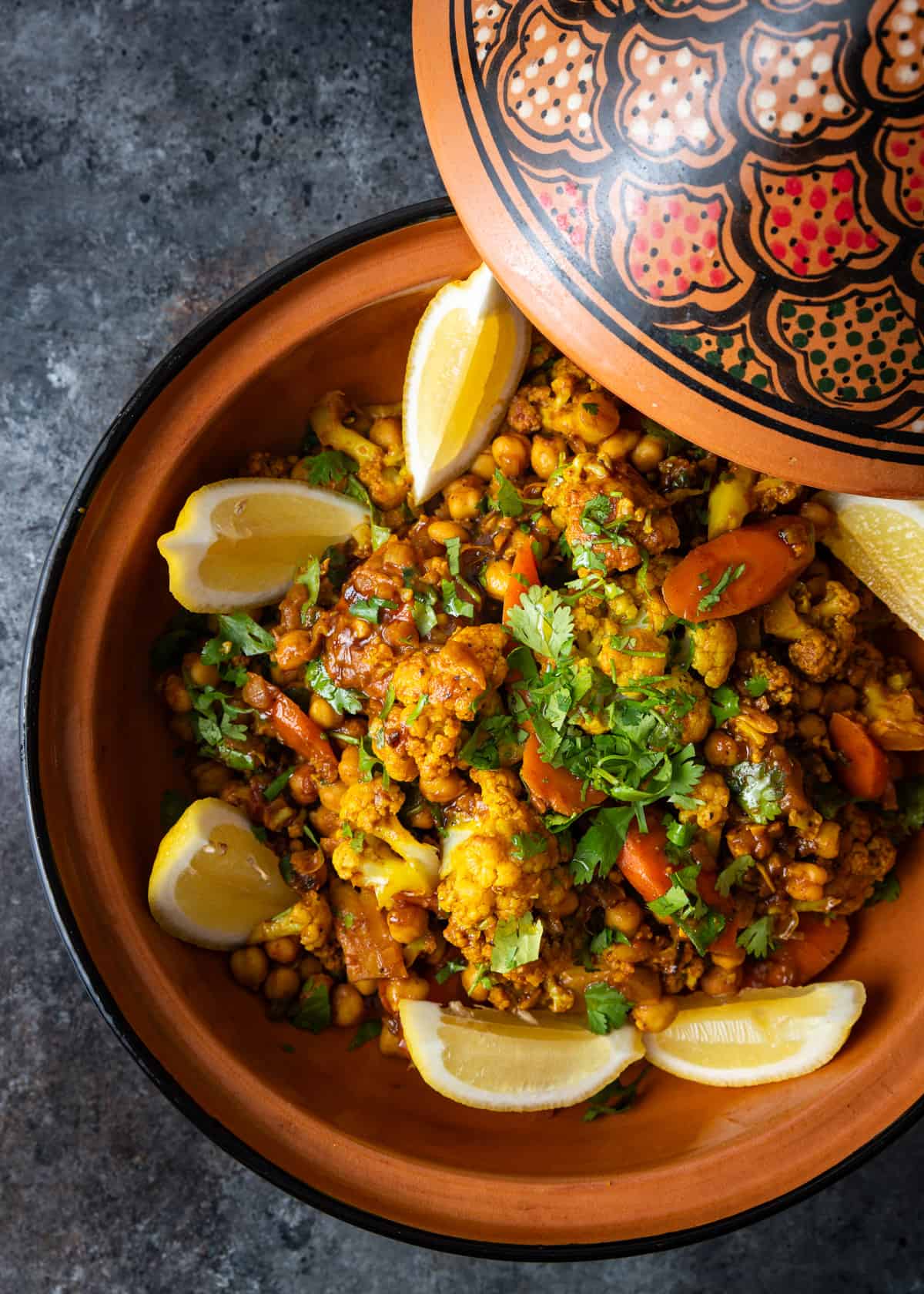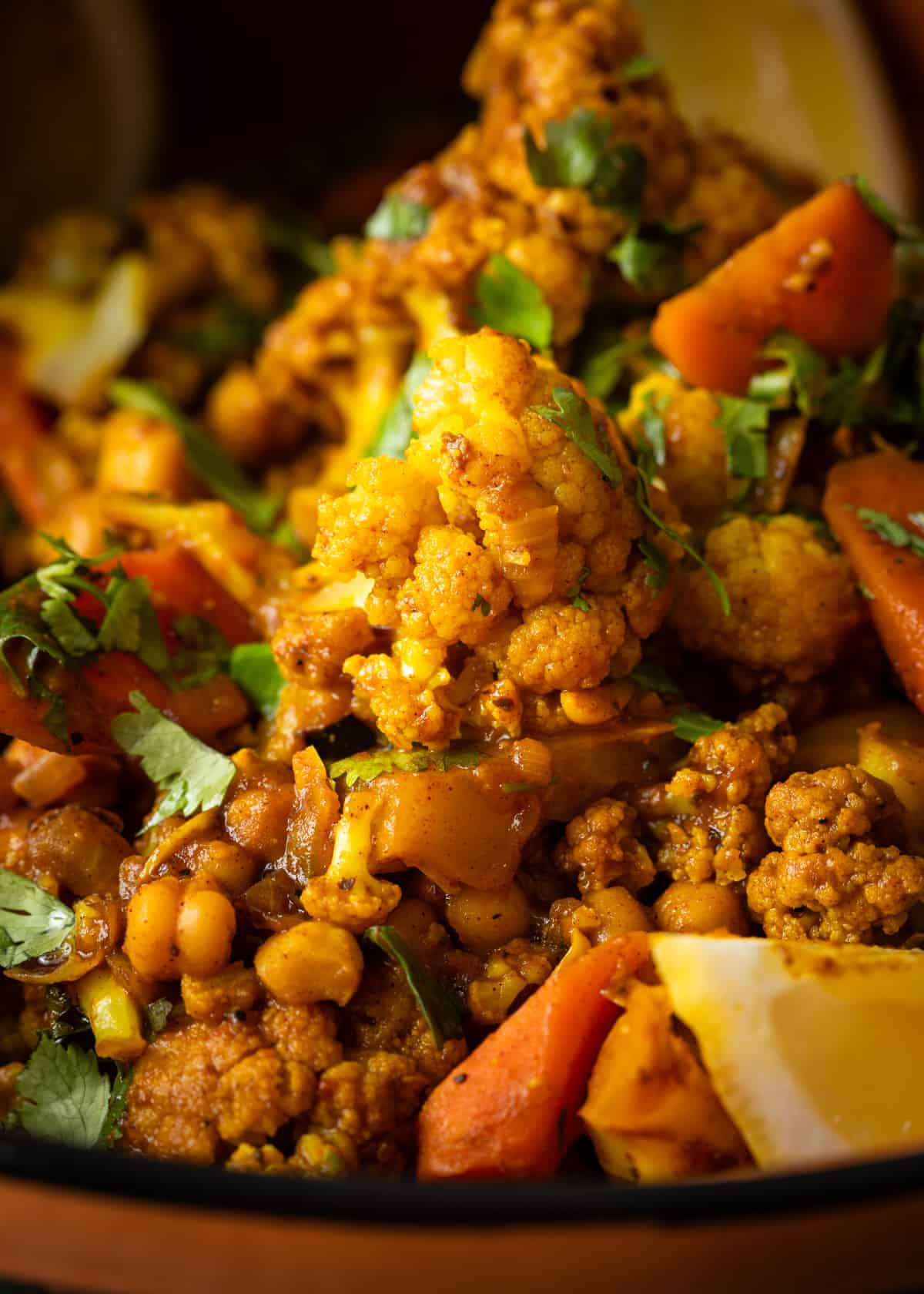This vegetable tagine is hearty, healthy, and loaded with authentic North African flavor. Carrots, cauliflower, and chickpeas are simmered to perfection with onion, garlic, and loads of rich, aromatic spices. Make this vegetarian feast in just 30 minutes!

This vegetable tagine recipe is filled with tender veggies, fresh herbs, and all the lavish flavors that make North African Cuisine so delicious. Tagines, like this Moroccan vegetable tagine, are known for their layers of mouthwatering flavor, and you will quickly understand why.
Turmeric, cumin, cinnamon, and cayenne give the dish depth and warmth, while rose water and honey add layers of delicate sweetness. Then, a dash of lemon adds the final, brightening touch. The ingredients are simple, and the recipe is easy, but the resulting vegetable tagine is going to really surprise you!

Other tagine recipes I’ve shared include this Lamb Tagine with Apricots and Dates, Beef Tagine with Sweet Potatoes Recipe, and this Chicken Tagine with Chickpeas and Olives!
For more authentic Moroccan recipes, check out my Moroccan Pastilla, Moroccan Meatballs, and this Moroccan Shakshuka.


Ingredient Notes and Substitutions
- Vegetables – This recipe features cauliflower, carrots, and chickpeas. Feel free to toss in a few of your favorite vegetables or legumes if desired.
- Oil or Ghee – Choose either a high-quality olive oil or ghee to add flavor-enhancing richness that brings the dish together. Ghee, also called clarified butter, can usually be found on the shelf with the other oils or in the international foods aisle.
- Yellow Onion – Yellow onions are my go-to for most tagine recipes, but red or white onions will work too.
- Garlic – Fresh garlic adds a sharp, earthy, pungency and zesty kick.
- Spices – Turmeric, cumin, cinnamon, cayenne, black pepper, and salt add layers of aromatic flavor and smoky warmth with a dash of spicy heat.
- Honey – Offers a layer of subtle, harmonizing sweetness.
- Rose Water – Infuses the tagine with a light floral essence and delicate sweetness. You can usually find it in the international aisle and always want to make sure you choose a food-grade brand.
- Toppings – Chopped cilantro and fresh lemon wedges add a freshness and brightness, along with a lively splash of colors.

What can I substitute for a tagine?
If you don’t own a tagine, substitute the widest, shallowest Dutch oven or heavy skillet you have (something good for low, slow cooking). Use a tight-fitting lid or tin foil in place of the conical tagine top.

How to Make Vegetable Tagine
- Sauté the Spices. Heat the oil or ghee over medium heat in a large skillet, Dutch oven, or tagine. Add the garlic and onion and saute until softened. Mix in the turmeric, cumin, cinnamon, cayenne, salt, and black pepper and stir to fully incorporate.
- Add the Vegetables. Add the cauliflower florets and carrots to the pot, along with 1 ½ cups of water. Cover, reduce the heat to low, and simmer for about 15 minutes. Remove the lid, thoroughly stir in the chickpeas, and cook for another 5 minutes.
- Add the Finishing Touches. Right before it is time to serve, drizzle the honey and rose water over the top of the tagine. Gently stir it into the stew. Serve topped with cilantro leaves and lemon wedges for seasoning.

Frequently Asked Questions
A tagine is basically a special class of North African stew. They are traditionally made in a special cone-shaped cooking vessel, also called a tagine.
These slow-cooked stews are known for having layers of savory, sweet, and aromatic flavors. They might be vegetarian, like this Moroccan vegetable tagine, or might include lamb, chicken, or other meats. A variety of vegetables, dried fruits, and nuts are included along with loads of warming aromatic spices. Tagines are crafted with care and loaded with flavor.
A stew, on the other hand, is any combination of ingredients that are slow-cooked and simmered in liquid until tender. Just about every culture along the Silk Road has a version!
While this vegetable tagine recipe does not require a tagine, there are a couple of benefits to cooking in one. The conical shape of the dish creates a circulating steam effect that renders the food perfectly tender without the need for too much liquid. This can condense flavors and give your recipe an overall richer taste. Don’t worry, though — a Dutch oven with a tight-fitting lid will get you pretty close.
Traditional clay tagine pots, when properly seasoned and cared for, can also infuse the dish with an extra layer of earthy flavor, making your dish even more authentic. There are several types of tagines out there now, so just be sure to do some research before investing.
Share this recipe on Pinterest!
Love this recipe? Share it with the world on Pinterest.
-
In a deep skillet, Dutch oven or tagine, heat the oil over medium heat. Saute the onion and garlic until soft. Add the turmeric, salt, cumin, cinnamon, cayenne and black pepper, stirring to incorporate.
-
Add the cauliflower, carrots and 1 1/2 cups water. Cover and turn heat to low, simmer for 15 minutes. Remove the lid, add the chickpeas, stir through and cook another 5 minutes.
-
Before serving drizzle the honey and sprinkle the rose water over vegetables, stir and top with cilantro. Serve with lemon wedges.
Calories: 331kcal | Carbohydrates: 53g | Protein: 12g | Fat: 10g | Saturated Fat: 1g | Polyunsaturated Fat: 2g | Monounsaturated Fat: 6g | Sodium: 654mg | Potassium: 876mg | Fiber: 13g | Sugar: 19g | Vitamin A: 7857IU | Vitamin C: 70mg | Calcium: 118mg | Iron: 5mg
The information shown is an estimate provided by an online nutrition calculator. It should not be considered a substitute for a professional nutritionist’s advice.

Source link











